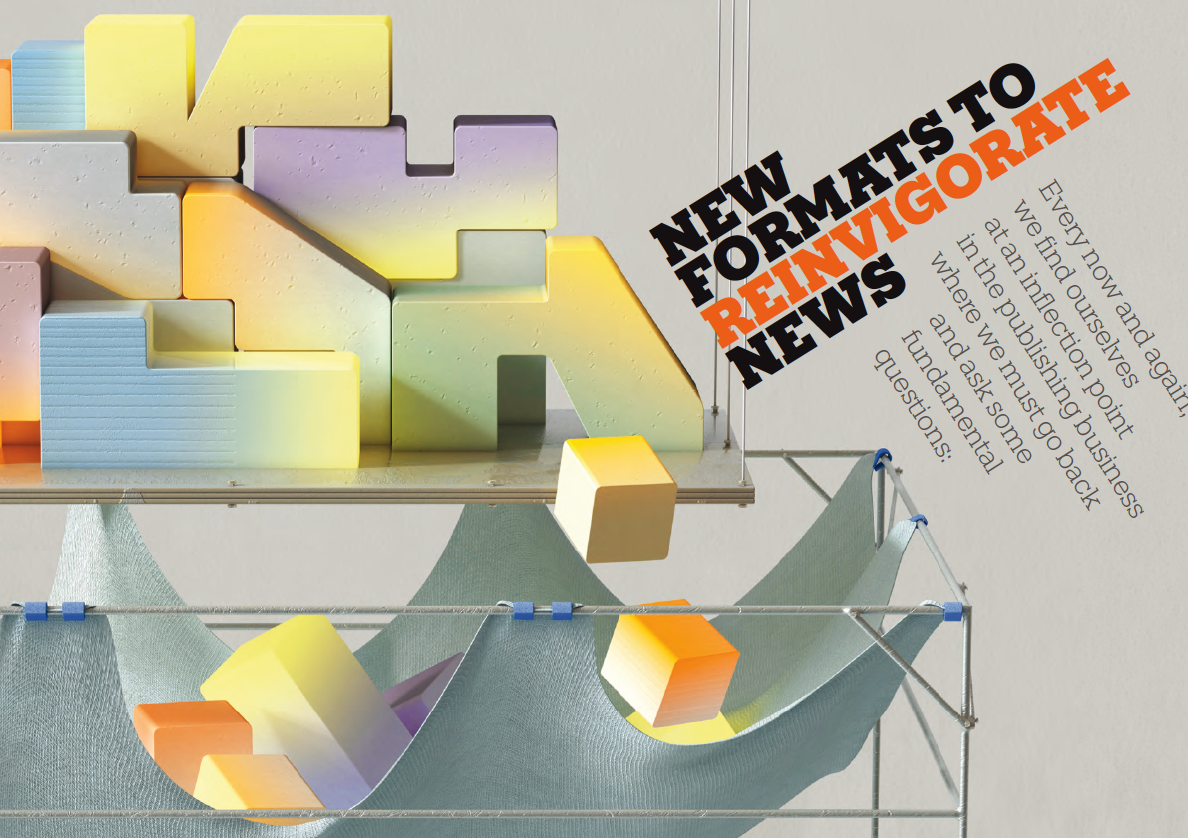
17 Oct New Formats to Reinvigorate News
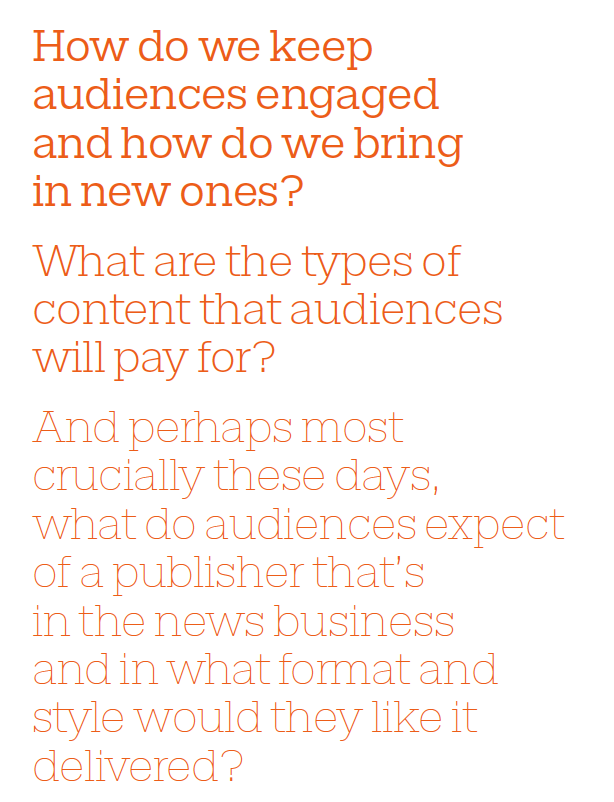
EVERY NOW AND AGAIN, the news story needs a refresh – a new form of presentation to adapt to the times. Story formats can seem like trivialities, especially when news companies continue to fall back on the same tropes when trying to come up with a successful formula — we need “hard hitting reporting”, “the story behind the story”, “more exclusives” etc. Yet, they can play a crucial, and sometimes under-appreciated, role in building a lasting connect with readers.
Forging such a connection is now more important than ever. With Generative AI, we are about to see an explosion of content on a scale scarcely imaginable. At the same time, the world of digital news is in the midst of a major transition. The BuzzFeed era, which roughly covered much of the 2010s, is now over. The closure of BuzzFeed News, along with the continuing struggles of Vox and Vice, marks the likely end of a model of media production that prioritised scale, viral content and social media distribution. Replacing that “new wave” of digital media now are newer players like Axios and Semafor who have diversified revenue models and prioritise newsletters over social media channels. And joining them in the charge ahead are a handful of legacy media organisations who have adapted and innovated for the times.
How do these organisations view the relationship between news and audiences and how does that affect the ways in which they present the news?
Why story formats are important
Let’s rewind a bit to talk a little more about the importance of story formats. As Brian Morrissey, former editor of Digiday who now runs the excellent
The Rebooting writes: “A unique story format can become intertwined with a brand and what it means, a calling card that is a core differentiator. Think The Economist’s un-bylined analysis, Snapchat Stories, New York Magazine’s approval matrix or Playboy’s regularly incisive Q&As.”
To this list, Morrissey adds several other formats that became synonymous with their brands — BuzzFeed’s listicles and quizzes, the Vox style explainer around whichthe brand built its entire proposition, the Daily Mail’s photo-heavy article format, Business Insider’s use of the slide show and Upworthy’s “You won’t believe” headline format.
Morrissey argues that formats are important yet invariably limited forms of differentiation, often just amounting to putting new packaging on the same
stuff. New formats can wear out their welcome and successful formats will, of course, be copied by publishers across the board and dilute any competitive advantage that the publisher may have had. Think of the BuzzFeed listicle that was adopted by hundreds of other publishers and eventually became tired. Or the explainer format that also became ubiquitous.
Yet the lure of creating new formats continues and is often a tactic a new publisher will go to. The best formats, Morrissey argues, are the ones that
look to solve an audience need. Only then can they avoid having just a fleeting resonance. With that principle in mind, we evaluate some of the best
innovations in formats going around today to see if things have evolved beyond the listicle and explainer.
SMART BREVITY AXIOS
IF YOU HAVEN’T HEARD OF AXIOS it’s a short, sharp, cleanly formatted news website adhering to the concept of Smart Brevity. The US news outlet, which sold to Cox Enterprises in August 2022 for $525 million after just five years of operation, has built its success through breaking the status quo of classic news writing: out with inverted pyramids, in with summaries and bullet-points. Look at any Axios news article and you will notice bold phrases, bullet points, punchy sentences, clear data, plenty of white space and very few quotes if any. This is to improve readability for mobile readers.
Each article starts with a brief introductory paragraph, followed by a series of sub-headed paragraphs that split the information into bite-size chunks. For example, a typical newsletter has six to ten “cards,” each summarising a noteworthy news item. Readers can skim until they hit stories they enjoy, read the whole thing top-to-bottom, or any other path they choose.
Launched in 2016 by the founders of Politico, Jim VandeHei and Mike Allen, Axios has expanded from its focus on newsletters into online and in-person events, podcasts and special investigations, and content streaming. Importantly, the outlet believes in atomising the news for readers, who the organisation found simply did not have the time or patience for lengthy news articles. It uses the term atomic units to capture how much of a story should be seen on the first loaded screen. The perfect atomic unit contains a headline, an image (i.e., illustration or data visualisation), and two paragraphs – the latter with an “Axiom”. Axioms are the bold terms or phrases that break the article into sections. The first one is often “why it matters?”, and around 50 other phrases are used in rotation, such as: “reality check”, “by the numbers”, “the other side” and “what they’re saying”.
So why does it matter?
In true Axios style, let’s break it all down by sub-heading. According to the 2022 Reuters Digital News Report, nearly three quarters of UK consumers
and half of US news consumers prefertext to video, a statistic that holds true across all age demographics. The study’s lead author Nic Newman believes this is because text is the quickest and easiest way for readers of any age to consume the news. In fact, the average reader spends 26
seconds on an article. Axios itself found that readers are turned off by big blocks of text, are under-informed on most topics, and are inundated with information, receiving anywhere between 70 and 400 notifications a day. As Axios editor-in-chief Sara Kehaulani Goo said in a podcast with Journalism.co.uk, “We’d all love to think people will read to the end of our 2,000-word story when in reality we know that’s just not the case.”
What is Smart Brevity?
The trademarked writing style called Smart Brevity, implying no wasted words and no wasted space, is audience-centric, informing all the text the digital news outlet puts out. Based on the essence of its slogan “’Write less, say more,” this technique helps readers scan for the information they need and go about their busy lives. Interestingly,
it concerns itself less with the idea of word count, and instead on the format of news writing. Axios’ format is ruled by concise, clear “research and writing techniques that make it deeply engaging to busy readers”, while “resist[ing] traffic-based assumptions to dumb things down”. In short, Axios believes in telling people what they need to know right away, telling them why they should care about it, and giving them the option of going deeper without making it mandatory. The concept is central to all operations – new Axios
hires learn Smart Brevity in an initial two-hour boot camp session, with follow-up training. Smart Brevity lays down six rules for good writing:
l Write for your audience, not yourself
l Sum up key information in single sentences
l Write like a human Write in tight subject-verb-object sentences.
l Use formats which are scannable, such as bullet points
l Remember that fewer words are more powerful
By the numbers
Axios’ newsletters give readers short news summaries, with the option to click through to a longer version. It has 2.7m newsletter subscribers across 20 different sectors and verticals, such as economy and business, technology and future, and health and science, a figure that promises growth in 2023. Goo says they could even double the cities they are in now within the next year or so, believing that the model is “something to be hopeful about in journalism.”
Axios claims to be profitable and is expected to reach over $100 million in revenue for 2023, most of which comes from advertising on the newsletters, website and podcasts. It
has also launched a new subscription product called Axios Pro, designed for investors and policy professionals.
The big picture
Covering a range of topics from space travel, to trade, to sports betting, to extreme weather and climate truths while maintaining a simple and readable approach that’s attractive to the uninitiated and initiated alike, Axios, according to Eliz Mizon in a Formats Unpacked piece, has “managed to make its niche news itself, growing into a serious – and crucially, trusted – industry player in only five years”.
What they’re saying
“America is screwed if we don’t restore fast a common connection, a common truth and a common reality,” VandeHei told The New York Times. “You do this with smart, clinical news and information — devoid of opinion and needless noise — pushed to consumers in an efficient, quick, respectful way.”
“The reason Axios’ Smart Brevity worked, even if it gets tiring to constantly be urged to Be Smart, is that there’s a job to be done in getting people smarter about the world
quickly,” Brian Morrissey writes in The Rebooting. “It’s no surprise that Axios was born in Washington, where most briefing documents are bullet pointheavy memos.”
Similar formats
Interestingly, news sites are beginning to follow in Axios’s footsteps. An example is UOL, one of Brazil’s largest news sites, that is using the Axios bullet-point style for its news stories. Among newsletters, Formats Unpacked employs a repeated, segmented format delivering brevity but curating important detail, as does Why Is This Interesting?, another Substack newsletter, and an aggregated variation: News In Bullets, part of the Newsreels app, which takes mainstream outlets’ news articles and simply lists their main points.
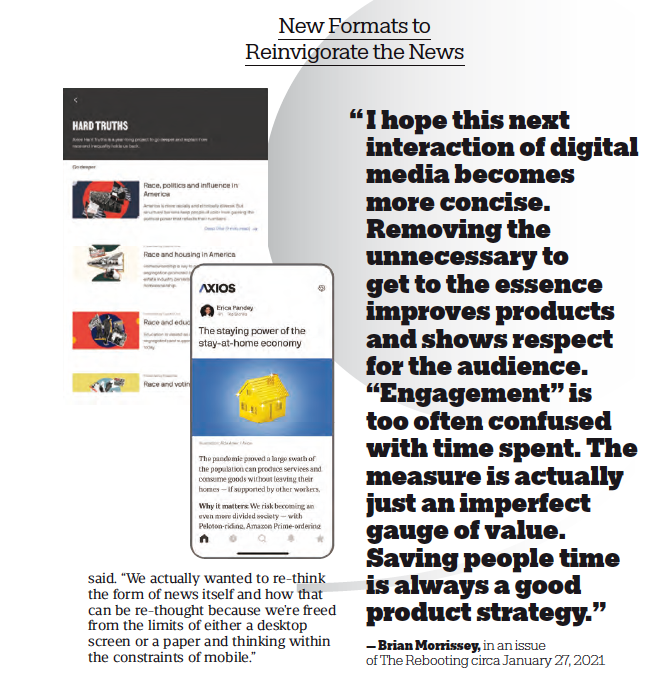
Older versions
The atomisation of news is not new. The Circa app, launched in 2012, enabled users to follow updates to certain stories which are broken down into bite-size information chunks – facts, quotes, statistics, events and images. This mobile-first approach to news delivery allowed for social sharing of an entire story, or instead users could share specific points within it. Founding Editor David Cohn told Journalism.co.uk that Circa was not a news organisation that was taking content and putting it on the phone, but a phone news content provider. “We didn’t want to take articles and squeeze them into a mobile phone,” he said. “We actually wanted to re-think the form of news itself and how that can be re-thought because we’re freed from the limits of either a desktop screen or a paper and thinking within the constraints of mobile.”
Vox’s card stacks, which debuted in 2014, are another example. Aiming to provide “explanatory journalism”, the editorial feature organised information, index card-style, about all kinds of topics that were in the news in plain English and an easy-to-navigate format. They aimed to add expertise to subjects and repurpose editorial content and recognised that news stories had a larger context to them.
The cards could also be continuously added to and embedded on other sites. This feature would not only help grow the Vox.com audience but provide a template for parent company Vox Media’s other verticals to use, as Curbed and Eater have done to showcase the best places to live and eat in a given city.
REIMAGINING THE NEWS STORY THE SEMAFORM
NEWS WEBSITE SEMAFOR, founded by former New York Times media critic Ben Smith and former CEO of Bloomberg Media Justin Smith, introduced the concept of “Semaform,” or what they call a redesign of “the atomic uni of written news, the article”.
The website has an explainer of Semaform, claiming it “separates the undisputed facts from the reporter’s analysis of those facts, provides different and more global perspectives, and shares strong journalism on the subject from other outlets.” To do this, articles are broken into:
l The News
l The Reporter’s View (or analysis)
l Room For Disagreement (or counterargument)
l The View From (or different perspectives on the topic)
l Notable (or some of the best other writing on the subject)
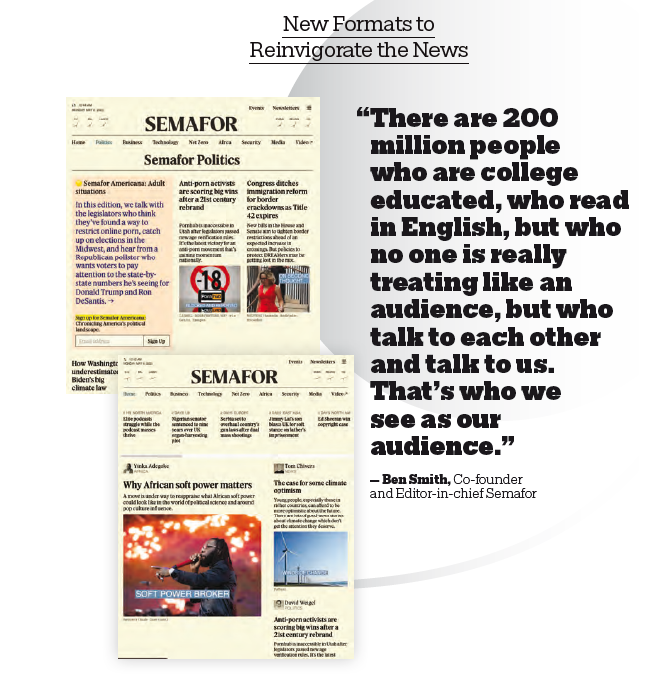
Semaform is built on the idea that most journalism today conflates fact and analysis and offers single perspectives with no opposing viewpoints. It serves to separate fact from reporter’s analysis, provide “different and more global perspectives, and share strong journalism on the subject from other outlets.” The aim, then, is to be more honest and offer news that readers can truly trust, is transparent, and provide broader, more varied perspectives. Importantly, the website is focused on addressing readers who feel overwhelmed by and distrustful of the media, giving them something readable and trustworthy.
Semafor aims to provide “distilled news, analysis, and opinion from a global range of sources,” summarised so “readers don’t have to search the internet trying to triangulate the truth.” For fast-moving news, the “facts” section is published first, and the other sections are filled out afterward, as more news comes in.
What’s the larger idea here? Morrissey writes that it is to, “separate out the opinion bit that’s embedded in news articles, sometimes passed off as analysis but sometimes seen as the source of distrust that an agenda is being served. Trust in news is regularly ranked fairly low and as per successive editions of the Reuters Institute Digital News Report, it is only getting lower.
“The gap is found when you talk to news consumers themselves, and you just have to look at the data, look at the research,” Justin Smith told The Rebooting. “And the level of frustration that news consumers have with their existing news ecosystem is actually very high. People are screaming from the rooftops, we’re tired of bias, we’re
tired of polarisation, we’re tired of editorial news being blended with opinion.”
“There are 200 million people who are college educated, who read in English, but who no one is really treating like an audience, but who talk to each other and talk to us,” Ben Smith weighed in another interview. “That’s who we see as our audience.”
That kind of editorial conviction that gave rise to the Semaform has also found resonance with reporters and in newsrooms. Ben Smith and executive editor Gina Chua told Sarah Scire in an interview for NiemanLabs there was a clear reason for this – it is a format that complements the newsroom’s natural workflow and basically replicates how a reporter would explain a story to the editor.
“I think this is exactly what editors do all the time,” Chua said. “Good editors take your story and hold you to account and say, ‘Well, have you thought about this? Have you thought about that?’ And what we’re doing here is taking that and putting it down in writing.” Reporters in the organisation have also been happy to categorise their writing into fact or opinion. “At some point, you get sick of pretending that this expert you’re quoting knows more than you do,” Ben Smith explained. “Or that you have no opinion or you have no analysis of your own.”
FINITE FORMATS
A CLEAR THEME FROM OUR discussion so far on the formats being experimented with by Axios and Semafor is the idea of cutting through the clutter of a lot of digital news content that’s out there today, in a way that is attuned to audience needs. It’s little wonder then, that as a natural extension, the finite format is now becoming an increasingly popular product in news publishing. In an excellent piece for Twipe published earlier this year, Matthew Lynes writes in Twipe of five factors central to the functioning of finite
formats, which drives their success.
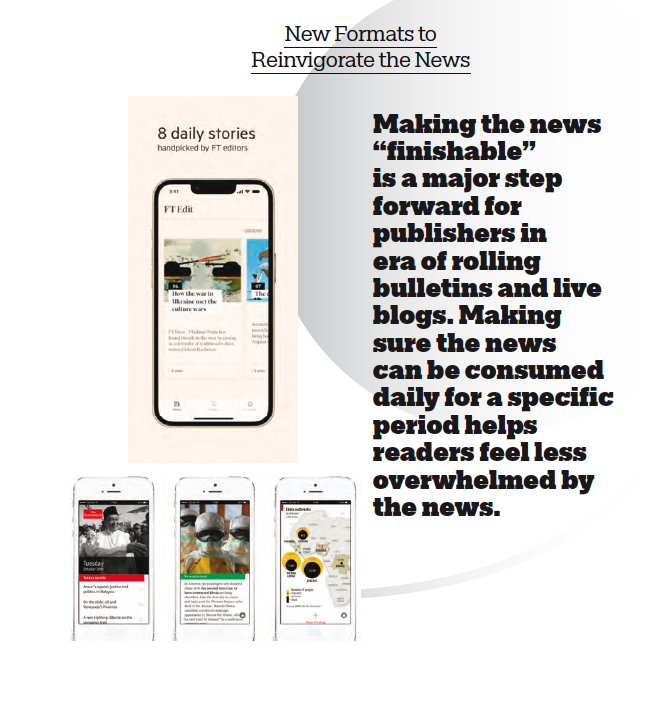
- Curation
Finite format products are all about curation. They feature a limited number of stories carefully chosen for the user. These stories are chosen to reflect the day’s news and provide readers with the information they need. This curation is central to building a trusting relationship between the newsroom and readers. Different successful products have different models of curation, with 2 standing out. The FT Edit features eight stories a day. The eight stories are chosen by an editor, with stories designed to expose readers to the breadth of the FT’s content, as well as encourage deep dives into topics seen in the daily news. The product is a source of experimentation for the FT, and recent trials have included guest editors. British-Nigerian entrepreneur Steven Bartlett took over the FT Edit for a day to provide readers with stories he considered to be the most important on the day. It also featured an extra bonus article from Bartlett himself to give a personal touch to readers.
Economist Espresso follows a similar curation format with just five stories chosen for each edition. These stories are specifically chosen to represent the five most important stories of the day, with each having to fit on one page of mobile so that readers can get their need-to-know facts as a quick hit, like an espresso. - Building usage habits
Building habits is an important way for publishers to keep readers coming back to their product frequently. This comes through exposing readers to a series of points on the
habit formation loop. Axios’ email newsletters, for instance, worked because they allowed the company to build habit with its audience in various verticals. Triggers like push notifications also encourage readers to engage more. With their digital edition being an evening product, Ouest France send push notifications to their users to let them know when the latest version of l’Edition du soir is available. This then takes readers directly to the latest edition. Inside Edition du soir, Ouest France also use puzzles and games to build habits. In the latest versions of their apps, FT Edit and Economist Espresso have also added quizzes as habit forming trigger These appeal to the competitive edge of readers wanting to test their knowledge and not lose streaks. - Fostering “finishability”
One of the key drivers for choosing a finite product is its finishability. Having a clear start and end as well as estimated read time helps fit news consumption into daily routines. At the top of each of its newsletters, Axios adds an estimated reading time and word count so subscribers can choose when it best fits their day to consume the content. Le Monde’s La Matinale has built on this by displaying both an expected read and listen time on each of its article cards. FT Edit however is best in class in terms of finishability. On the home page with the day’s articles, each article card gives an estimated read time. As readers progress through the story, there is a progress bar that can be seen on the home page and in the article. Once an article is finished, it is clearly marked with a completed label so that readers can move on to the next story. The Atlantic’s today section
also presents a strong example of finishability: once a reader has reached the end of the day’s six stories, the are informed that they have complete their news consumption for the day Making the news “finishable” is a majo step forward for publishers in an era o rolling bulletins and live blogs. Makin sure the news can be consumed dail for a specific period helps readers fee less overwhelmed by the news. - Engaging readers beyond words
Finding ways to engage readers beyond the news has become a driver for success with finite format products. Tamedia 12 and Le Monde’s La Matinale have leveraged swiping to encourage readers to actively sort the news. This adds an element of gamification to news consumption and has been utilised to make news more appealing to younger audiences. Swiping also reiterates the finite nature of the news product, with subscribers eventually reaching the end of a content bundle. Swiping has proved an easy yet powerful way to boost engagement. La Matinale’s use of audio follows a similar swipe model. When swiping through the day’s news, an audio article playlist of the chosen articles is also made and can be played in the background.
This means that in increasingly busy lives, subscribers can still enjoy the day’s news whilst multitasking, encouraging engagement with more than one of a subscriber’s senses.
Economist Espresso features a daily audio briefing at the top of each edition so subscribers can listen to the headlines of the day, as well as a recommended podcast of the day so subscribers can continue their daily consumption journey. - Being content-driven
Finite format products find success in their aesthetic appeal. Many of these tend to focus on simplicity and clean design. This encourages a greater focuson content, which is at the heart of the role of finite formats. L’Edition du soir bases its content on a variety of mobile designed templates to ensure that its content is displayed to users in the best possible way. Mobile optimised templates mean that users can also engage with other content like video, audio and pictures. These templates are made to be clean so that attention is not diverted from what readers need to know.
TaMedia 12 provides an animated slide show of the 12 stories selected for the day when entering the app. This provides readers with a teaser of the stories in the day’s curation of articles and gives an aesthetically pleasing onboarding. Economist Espresso features an interactive chart of the day and animated fact of the day to provide users with content in an interactive format. Finding ways to make content appear effortless and classic is a great way to ensure greater interaction with content and less distraction from interruptive ads
AUDIO FORMATS
INNOVATION STORY FORMATS don’t have to be confined to text, and audio is increasingly emerging as a very reliable medium indeed for the delivery of news. According to the Reuters Institute for the Study of Journalism’s predictions for 2023, 72% of publishers plan to invest in audio in 2023 as a new way to engage subscribers and attract new users. This finding is well in alignment with the statistics in the 2023 BeyondWords Audio Engagement Report; 46% of Americans were found to consume spoken word content daily in 2022, with spoken word comprising 51% of daily audio consumption. Considering this is 2% greater than their music consumption, the continued focus on audio is no surprise. It is evident that the demand for spoken word audio content remains high.
Content that has an audio option attracts – and retains – more attention, statistics say. BeyondWords analysed 17 million audio plays on their integrated players and found
the average listen rate was 4.19%, i.e., one in every 25 audio player loads resulted in a click. It also reported an average playback duration of 59%, around 3 minutes 45 seconds,
far greater than the average time on page, which is a mere 55 seconds. Besides the now ubiquitous podcast, publishers are looking at new, innovative uses of audio to engage and retain users.
Voice Note Journalism
Transforming from mere message to a medium in itself, voice notes have become the subject of much experimentation. Local American news start-up Sahan Journal, for instance, has launched a voice note newsletter Tani waa su’aashayda to reach Somalis in Minnesota, home to the largest Somali population in the United States. Sahan Journal was founded in 2019 by CEO and publisher Mukhtar Ibrahim to serves the news needs of immigrant communities and communities of colour in Minneapolis and throughout
the state.
Meaning “this is my question” in Somali, Tani waa su’aashayda was developed after a year of listening sessions funded by Google News Initiative and conducted in partnership with the media outlets that serve Minneapolis’s large Spanish, Hmong, and Somali-speaking communities: La Raza 95.7 FM, 3HmongTV, and Somali TV. These listening sessions involve immigrant, refugee, and non- English-speaking communities across Minnesota. Tani waa su’aashayda challenges the traditional newsletter
format with no written text. Crucially, the question posed by Somali users — and their feedback — is central to the enterprise. Co-produced by editor Aala Abdullahi and Somali TV’s Diis, it is audio-only, with platform GroundSource used to send audio files in Mp3 format to subscribers via SMS. This format allows direct, intimate communication to an
audience without depending on social media and drives the organisation’s reporting on matters of concern to the community.
How it works
Subscribers sign up, after which they receive a voice note that explains what the newsletter is and how users’ feedback will inform the content and growth of the newsletter. Every week, Diis records an audio summary of three or four local news stories. This could also include the latest news from Somalia. He then tells subscribers about upcoming local events that Somalis can be involved in. Finally, Diis asks subscribers for feedback on the week’s offering and invites them to share their questions for journalists.These questions in turn decide future Sahan Journal stories, newsletter callouts, and community discussion.
The newsletter is sent out in sections. Each section is recorded in a separate voice note and sent out through the week, not exceeding six times.However, for a user who’d rather listen to the entire newsletter in one place and in one sitting, the voice notes are uploaded to Sahan Journal’s webpage. And for those who’d prefer a visual element, the audio files are compiled alongside photos and graphics into a video that is uploaded to YouTube.
With 211 subscribers as of early 2023, and having received more than 400 texts from 151 users, Tani waa su’aashayda is proving a successful community-driven model whose learnings Sahan Journal hopes to apply to launch similar newsletters for Hmong and Spanishspeaking communities in Minnesota. Importantly, the media company aims at a model that is simple, interactive, and reproducible, and has people at the centre rather than profits. “We want to keep it bare bones,” Abdullahi told Nieman Lab. “A lot of newsrooms that are similar in size to Sahan Journal are actively thinking about how to incorporate community engagement and feedback into their journalism, and are thinking about distribution models. We want to focus on a model that people could replicate.”
BBC
The BBC is no stranger to leveraging the power of WhatsApp in its work – it was the first media organisation to integrate news reporting through WhatsApp with its coverage of the 2014 Indian elections, significant in a country that, during this time, had the highest concentration of WhatsApp users. This led to a large, interactive, and
familiarised audience subscribing to the service, which proved to be advantageous for building a subscriber base. The organisation has now moved to harnessing the potential
of the easy-to-use voice note as a means of widening audience engagement. For certain live shows and podcasts, listeners are invited to send their questions or comments to production teams via WhatsApp voice notes. Selected messages are played and addressed through the shows. This has helped the public broadcaster interact more closely with its audiences and allows for feedback to inform content.
THE AUDIO ARTICLE
Though in no way novel, audio articles are another way to deepen audience engagement, and continue to see adoption and innovation from publishers. After the success of the podcasts L’Heure du Monde, Le Goût de M and Human Heat, Le Monde went one step further with its experiments with audio. Late last year, Le Monde, which retains approximately 70,000 users each month (totalling 1.5 million visits, added audio functionality to its “La Matinale” app. Once added to the daily reading list, articles can be played
individually. It is also possible for them to autoplay in playlist format, allowing the user greater autonomy and ensures a smoother user experience. In fact, users can create a personalised journal choosing which articles to retain and which to discard. While existing subscribers can read and listen to all articles in their entirety, nonsubscribed readers only have access to the audio versions of free articles. By allowing its readers to easily identify what is important, La Matinale works on facilitating a clean user experience. In each edition, key news articles are presented alongside ideas for cultural outings or trips, and some previews of the newspaper. The new listening feature even has its own
sound signature: AI-synthesised, it features the voices of six actors. This innovation aims to broaden the audience of La Matinale, by reaching new types of readers, but also to
retain its subscribers by offering them a new, more immersive user experience.
The Innovation in News Media World Report is published every year by INNOVATION Media Consulting in association with WAN-IFRA, The report is co-edited by INNOVATION President, Juan Señor, and Senior Consultant Jayant Sriram


